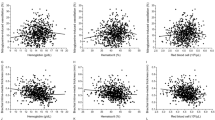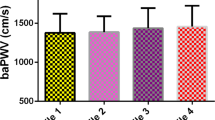Abstract
The association of blood hemoglobin (Hb) concentration and red blood cell (RBC) count with arterial stiffness is not well-defined. Herein, we examined the associations of brachial–ankle pulse wave velocity (baPWV) and augmentation index (AI) with Hb level and RBC count from a population cohort in and around Beijing, China. A total of 3994 participants (57.1 ± 8.8 years old) were included in our analysis. Blood routine examination, baPWV, and possible covariates were examined. The mean Hb, RBC count, AI corrected for a heart rate of 75 bpm (AIP75), and baPWV were 131.4 ± 17.1 g/l, 4.2 ± 0.5 1012/l, 80.2 ± 12.0%, and 1665.3 ± 377.1 cm/s, respectively, consistent with previously described cohorts. RBC counts and Hb levels were positively associated with baPWV (β for 1012/l RBC: 50.08 cm/s, 95% confidence interval [CI]: 30.54–69.63, p < 0.001; β for 10 g/l Hb: 9.05 cm/s, 95% CI: 3.35–14.76, p = 0.002) and AIP75 (β for 1012/l RBC: 1.33%, 95% CI: 0.55–2.12, p < 0.001; β for 10 g/l Hb: 0.34%, 95% CI: 0.12−0.57, p = 0.003), despite adjustment for covariates. The average levels of baPWV in the third–fourth quartile RBC groups were higher than in the first quartile (Q1) group (p < 0.001 for all). The average levels of baPWV in the fourth quartile Hb groups were higher than in the Q1 Hb group (p = 0.038). Mean AIP75 levels in the third−fourth RBC and Hb groups were higher than in the Q1 groups (p < 0.05 for all). In conclusion, circulating blood Hb levels and RBC counts are positively associated with arterial stiffness in our community-based study.
This is a preview of subscription content, access via your institution
Access options
Subscribe to this journal
Receive 12 digital issues and online access to articles
$119.00 per year
only $9.92 per issue
Buy this article
- Purchase on Springer Link
- Instant access to full article PDF
Prices may be subject to local taxes which are calculated during checkout


Similar content being viewed by others
References
Schaffer A, Verdoia M, Cassetti E, Marino P, Suryapranata H, De Luca G. Relationship between homocysteine and coronary artery disease. Results a large prospective cohort study. Thromb Res. 2014;134:288–93.
Townsend RR, Wilkinson IB, Schiffrin EL, Avolio AP, Chirinos JA, Cockcroft JR, et al. Recommendations for improving and standardizing vascular research on arterial stiffness. Hypertension 2015;66:698–722.
Mattace-Raso F, van der Cammen T, Hofman A, van Popele NM, Bos ML, Schalekamp M, et al. Arterial stiffness and risk of coronary heart disease and stroke–the Rotterdam Study. Circulation 2006;113:657–63.
Nürnberger J, Keflioglu-Scheiber A, Saez AO, Wenzel RR, Philipp T. Augmentation index is associated with cardiovascular risk. J Hypertens. 2002;20:2407–14.
Townsend RR, Wilkinson IB, Schiffrin EL, Avolio AP, Chirinos JA, Cockcroft JR, et al. Recommendations for Improving and Standardizing vascular research on arterial stiffness: a scientific statement from the American Heart Association. Hypertension 2015;66:698–722.
Kalra PR, Greenlaw N, Ferrari R, Ford I, Tardif J, Tendera M, et al. Hemoglobin and change in hemoglobin status predict mortality, cardiovascular events, and bleeding in stable coronary artery disease. Am J Med. 2017;130:720–30.
Winther SA, Finer N, Sharma AM, Torp-Pedersen C, Andersson C. Association of anemia with the risk of cardiovascular adverse events in overweight/obese patients. Int J Obes. 2014;38:432–7.
Horne BD, Anderson JL, Muhlestein JB, Ridker PM, Paynter NP. Complete blood count risk score and its components, including RDW, are associated with mortality in the JUPITER trial. Eur J Prev Cardiol. 2014;22:519–26.
Vinhas J, Barreto C, Assunção J, Parreira L, Vaz A. Treatment of anaemia with erythropoiesis-stimulating agents in patients with chronic kidney disease does not lower mortality and may increase cardiovascular risk: a meta-analysis. Nephron Clin Pr. 2012;121:c95–101.
Neil A, Zakai M, Ronit Katz P, Calvin Hirsch M, Michael G, Shlipak MM, et al. A prospective study of anemia status, hemoglobin concentration, and mortality in an elderly cohort. Arch Intern Med. 2005;165:2214–20.
Da Silva Garrote-Filho M, Bernardino-Neto M, Penha-Silva N. Influence of erythrocyte membrane stability in atherosclerosis. Curr Atheroscler Rep. 2017;19:4.
Lin H, Xu X, Lu H, Li C, Tang M, Sun H, et al. Pathological mechanisms of erythrocyte-induced vulnerability of atherosclerotic plaques. Med Hypotheses. 2008;70:105–8.
Pasterkamp G, Virmani R. The erythrocyte: a new player in atheromatous core formation. Heart 2002;88:115–6.
Mozos I, Luca CT. Crosstalk between oxidative and nitrosative stress and arterial stiffness. Curr Vasc Pharm. 2017;15:446–56.
Siebenmann C, Cathomen A, Hug M, Keiser S, Lundby AK, Hilty MP, et al. Hemoglobin mass and intravascular volume kinetics during and after exposure to 3,454-m altitude. J Appl Physiol. 1985;2015:1194–201.
Kawamoto R, Tabara Y, Kohara K, Miki T, Kusunoki T, Katoh T, et al. A slightly low hemoglobin level is beneficially associated with arterial stiffness in Japanese community-dwelling women. Clin Exp Hypertens. 2012;34:92–8.
Montero D, Diaz-Cañestro C, Keiser S, Lundby C. Arterial stiffness is strongly and negatively associated with the total volume of red blood cells. Int J Cardiol. 2016;221:77–80.
Fan F, Qi L, Jia J, Xu X, Liu Y, Yang Y, et al. Noninvasive central systolic blood pressure is more strongly related to kidney function decline than peripheral systolic blood pressure in a chinese community-based population. Hypertension 2016;67:1166–72.
Momin M, Li JP, Zhang Y, Fan FF, Xu XP, Xu X, et al. Body mass index is inversely associated with arterial stiffness in Chinese adults with primary hypertension: results from the China Stroke Primary Prevention Trial (CSPPT). Clin Exp Hypertens. 2017;39:394–401.
Chen H, Hua Q, Hou H. Association of hemoglobin with ambulatory arterial stiffness index in untreated essential hypertensive patients without anemia. Intern Med. 2011;50:2759–65.
Doba N, Tokuda Y, Tomiyama H, Goldstein NE, Kushiro T, Hinohara S. Changes in ankle brachial pulse wave velocity during a five-year follow-up period in older Japanese adults: sub-analysis results of the health research volunteer study in Japan. Intern Med. 2013;52:21–7.
Shimizu Y, Nakazato M, Sekita T, Kadota K, Yamasaki H, Takamura N, et al. Association between hemoglobin levels and arterial stiffness for general Japanese population in relation to body mass index status: the Nagasaki Islands study. Geriatr Gerontol Int. 2014;14:811–8.
Meyer ML, Tanaka H, Palta P, Cheng S, Gouskova N, Aguilar D, et al. Correlates of segmental pulse wave velocity in older adults: the Atherosclerosis Risk in Communities (ARIC) study. Am J Hypertens. 2016;29:114–22.
Schwarz CP, Koppelstaetter C, Amann E, Mayer G. Impact of anemia on aortic pulse wave velocity in hemodialysis patients. Kidney Blood Press Res. 2009;32:210–6.
Harusato I, Fukui MM, Shiraishi E, Senmaru T, Sakabe K. Hemoglobin concentration in men with type 2 diabetes mellitus. Metabolism 2010;59:808–13.
Jia EZ, An FH, Liu P, Li F, Mao HW, Cui WJ, et al. Relationship between brachial-ankle pulse wave velocity and cardiovascular risk factors: a multi-ethnic study. Intern Med. 2012;51:537–43.
Tanne D, Molshatzki N, Merzeliak O, Tsabari R, Toashi M, Schwammenthal Y. Anemia status, hemoglobin concentration and outcome after acute stroke: a cohort study. BMC Neurol. 2010;10:22.
Kengne AP, Czernichow S, Hamer M, Batty GD, Stamatakis E. Anaemia, haemoglobin level and cause-specific mortality in people with and without diabetes. PLoS ONE. 2012;7:e418758.
Besarab A, Bolton WK, Browne JK, Egrie JC, Nissenson AR, Okamoto DM, et al. The effects of normal as compared with low hematocrit values in patients with cardiac disease who are receiving hemodialysis and epoetin. N Engl J Med. 1998;339:584–90.
Singh AK, Szczech L, Tang KL, Barnhart H, Sapp S, Wolfson M, et al. Correction of anemia with epoetin alfa in chronic kidney disease. N Engl J Med. 2006;355:2085–98.
Drüeke TB, Locatelli F, Clyne N, Eckardt K, Macdougall IC, Tsakiris D, et al. Normalization of hemoglobin level in patients with chronic kidney disease and anemia. N Engl J Med. 2006;355:2071–84.
Goliasch G, Schillinger M, Mayer FJ, Wonnerth A, Koppensteiner R, Minar E, et al. Usefulness of hemoglobin level to predict long-term mortality in patients with asymptomatic carotid narrowing by ultrasonography. Am J Cardiol. 2012;110:1699–703.
Fossum E, Hoieggen A, Moan A, Nordby G, Velund TL, Kjeldsen SE. Whole blood viscosity, blood pressure and cardiovascular risk factors in healthy blood donors. Blood Press. 1997;6:161–5.
Kutlu M, Sonmez A, Genc H, Erdem G, Tapan S, Celebi G, et al. Relationship between hemoglobin and CD40 ligand in prediabetes. Clin Invest Med. 2009;32:E244–50.
Mach F, Schonbeck U, Libby P. CD40 signaling in vascular cells: a key role in atherosclerosis? Atherosclerosis 1998;137S:S89–95.
Tziakas DN, Chalikias GK, Stakos D, Tentes IK, Papazoglou D, Thomaidi A, et al. Independent and additive predictive value of total cholesterol content of erythrocyte membranes with regard to coronary artery disease clinical presentation. Int J Cardiol. 2011;150:22–7.
Miwa S, Inouye M, Ohmura C, Mitsuhashi N, Onuma T, Kawamori R. Relationship between carotid atherosclerosis and erythrocyte membrane cholesterol oxidation products in type 2 diabetic patients. Diabetes Res Clin Pract. 2003;61:81–8.
Facchini FS, Carantoni M, Jeppesen J, Reaven GM. Hematocrit and hemoglobin are independently related to insulin resistance and compensatory hyperinsulinemia in healthy, non-obese men and women. Metabolism 1998;47:831–5.
Barbieri M, Ragno E, Benvenuti E, Zito GA, Corsi A, Ferrucci L, et al. New aspects of the insulin resistance syndrome: impact on haematological parameters. Diabetologia 2001;44:1232–7.
Choi KM, Lee J, Kim YH, Kim KB, Kim DL, Kim SG, et al. Relation between insulin resistance and hematological parameters in elderly Koreans-Southwest Seoul (SWS) Study. Diabetes Res Clin Pract. 2003;60:205–12.
Metivier F, Marchais SJ, Guerin AP, Pannier B, London GM. Pathophysiology of anaemia: focus on the heart and blood vessels. Nephrol Dial Transpl. 2000;15:14–8.
Acknowledgements
We thank Liwen Bianji, Edanz Editing China (www.liwenbianji.cn/ac), for editing the English text of a draft of this manuscript.
Funding
This study was supported by the UM-PUHSC Joint Institute for Translational and Clinical Research (Grant Nos: BMU20110177 and BMU20160530). SKG is supported by R01HL122684 and R01HL139672.
Author information
Authors and Affiliations
Corresponding authors
Ethics declarations
Conflict of interest
The authors declare that they have no conflict of interest.
Additional information
Publisher’s note Springer Nature remains neutral with regard to jurisdictional claims in published maps and institutional affiliations.
Supplementary information
Rights and permissions
About this article
Cite this article
Sun, P., Jia, J., Fan, F. et al. Hemoglobin and erythrocyte count are independently and positively associated with arterial stiffness in a community-based study. J Hum Hypertens 35, 265–273 (2021). https://doi.org/10.1038/s41371-020-0332-6
Received:
Revised:
Accepted:
Published:
Issue Date:
DOI: https://doi.org/10.1038/s41371-020-0332-6



